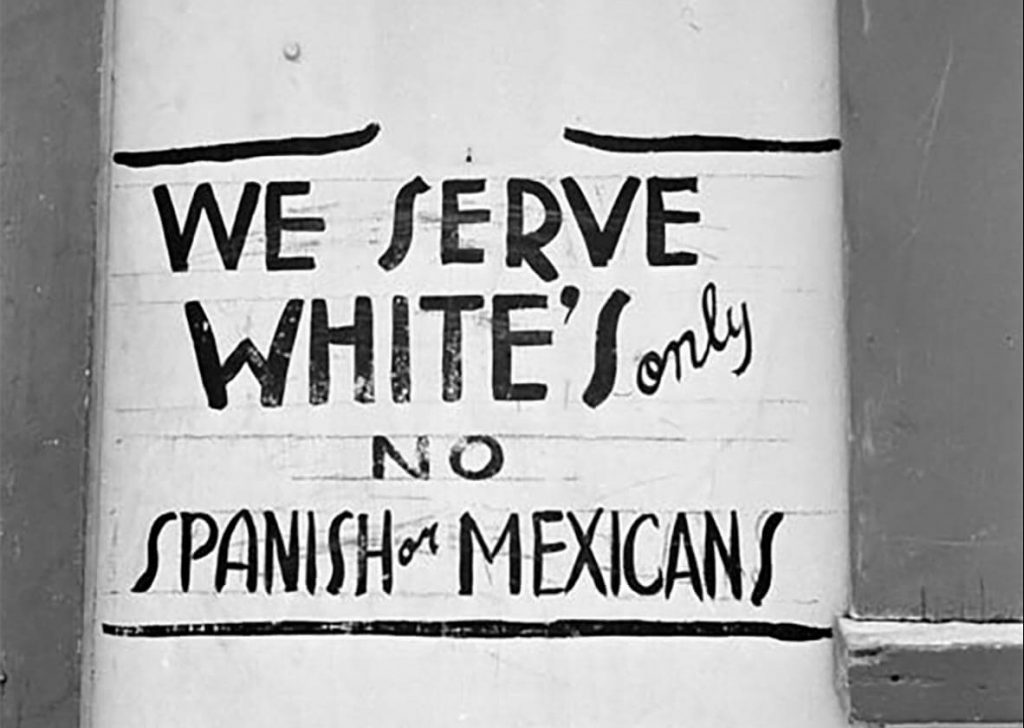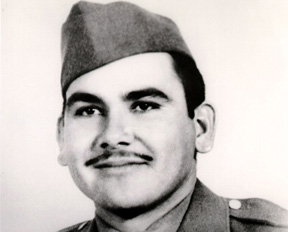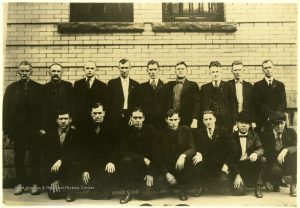1911, Antonio Gomez, a fourteen-year-old Mexican-American boy, was walking home carving pieces of wooden shingles, when suddenly a saloon owner shoved him to the street. Gomez was scolded by the saloon owner for littering on the sidewalk shouting, “the sidewalk is no wastebasket.” A group of men that was at the saloon cheered on the owner and cursed at Gomez. As the boy gathered his shingles and tried to leave, a man by the name of Charles Zieschang snatched the wooden shingles from the boy’s hand and told the owner he could, “make the damn little skunk quit whittling.” Zieschang whipped Antonio Gomez with his own wooden shingles while other men watched and ridiculed the boy. Out of self-defense Antonio Gomez stabbed Zieschang with the pocket knife he was using to carve the wooden shingles. Zieschang died from blood loss in twenty minutes.1

Mexican-Americans were somewhat immune to the racist Jim Crow policies of the south that made discrimination against black Americans legal. This was due to the fact that Mexicans were “white by law” since the signing of the Treaty of Guadalupe Hidalgo in 1848. So, the Juan Crow laws emerged as a way to legally discriminate against Mexican Americans. Through Juan Crow prejudices, Texas passed English-only laws that led to future segregation of Mexican-Americans in school systems. Anglos pushed for segregation of Mexican-Americans in school because they believed having their children learn alongside Mexican-American children would hinder them. Segregationists also believed that it was safer for their white children because they believed Mexican-Americans reached puberty earlier. Unsurprisingly the anti-Mexican efforts were blind-sided by authorities across the state giving more power to Juan crow laws that essentially justified discrimination and mistreatment of Mexican-Americans.2

Antonio Gomez was taken into custody almost immediately by constable McCoy and taken into the town jail of Thorndale, Texas. Soon after his arrest, another version of the altercation went around. Some were claiming that Gomez was the attacker who waited for Zieschang to come out of the saloon after having snatched his wooden shingle and peacefully retreating to the saloon. The people were so eager to bring their own “justice” that they were willing to act as witnesses without having seen anything. Although history has yet to prove which story is the most accurate, the only part that remains constant is the events that led up to his death. Gomez became an instant target for lynching because the citizens knew he was too young for capital punishment in the state of Texas, but they were willing to take matters into their own hands. It was reported that a mob of more than a hundred people waited for justice outside the jail. Constable McCoy who placed Gomez in jail tried to transfer him to another jail out of fear that the boy would be lynched by the people. The constable knew that the small jail could keep Antonio Gomez in, but he wasn’t sure that it could keep an angry mob out. Gomez was led through the back of the jail with a chain around his neck and straight to a house. McCoy went to look for reliable transportation to another jail while Gomez was kept in a safe place, or so he thought. Somehow the angry mob learned the location of Antonio Gomez and managed to steal him from authorities.3
Racism had grown its roots very deep and brutally here in the state of Texas. Racism in Texas stems back not only to slavery and the prejudice towards black people, but to native Americans as well. Mexicans were sometimes saved by the law which would recognize a Mexican person as “white” as long as their skin permitted it. If you were not of fair skin, then you risked being persecuted. Most Anglo-Americans had an “us versus them” mentality when it came to Mexican-Americans. This was because many Anglo-Americans picked up on American nationalism and nativism going against Mexican-Americans who were wrongly stereotyped. Mexican-Americans were usually seen as inferior, violent, and even anti-American. Racism against Mexican-Americans was like a double-edged sword. Mexican-Americans had to deal with Anglo-Americans who did not accept them and did not think they were American enough. Simultaneously, Mexican-Americans dealt with Mexicans who also thought less of Mexican-Americans, often times looking at them as traitors. Racism in the state of Texas was not only on the mere surface, but it had also been implemented systematically, from the school systems to the housing system and even the labor systems. This is because our country’s story is based on a consensus history, which means that our history is based on points of view that seeks to paint an exciting picture of our history, and downplaying the tragedies that occurred.4

Antonio Gomez was captured by an angry mob and was dragged by a horseman who managed to grab the chain that was around Gomez’s neck. Antonio Gomez’s body was found lifeless hanging from a telegraph pole next to a ladder. Only three hours had passed since the death of the man that Gomez was charged for “murdering.” The body of the child was found bruised up and beaten horribly with a chain around his neck. After beating the boy and dragging him, the men mercilessly suspended his body from the pole. Before the men managed to hang his body, they had a failed attempt where they dropped his body and kicked his head. The constable was too late when he arrived at the scene.5
How common were these anti-Mexican lynching’s? Although hateful crimes against Mexicans were common, it was not so common to be recorded for history. There are records to show that from 1848 to 1928 at least 597 deaths of Mexicans in Texas were due to mob violence or lynchings. These attacks directed towards Mexicans and Mexican-Americans were not only done by other citizens, but they were also planned systematically by Texas Rangers. Another example of brutal deaths by mob violence is the lynching and burning of Antonio Rodriguez. These acts of terror were very common in Texas, especially towards ethnic groups such as African Americans, Mexicans, and even native Americans even earlier.6

It is important to know the stories of such victims of racism and mob violence like that of Antonio Gomez or even of Jesse Washington. Although these stories are not the most appealing, it is important to recognize these people and their stories because it is our history whether we like it or not. It is important for all people to know the truth. Stories like these are even relevant today. We could look at recent laws such as SB4 that encouraged racism among law enforcement, or even the stereotypes that current president Trump has promoted. The story of Antonio Gomez shows just how far and systematic racism has been in our state of Texas or even in our country. It is important to know the entire truth of history, not just one point of view. Why haven’t you heard of Antonio Gomez? Why was Mexican-American studies just recently added to the Texas public school curriculum in 2014, and only as an elective? Why isn’t the history of Mexican people in our textbooks when it is a vital part of who we are and where we come from, especially here in Texas?
- Nicholas Villanueva,The Lynching of Mexicans in the Texas Borderlands (Albuquerque: University of New Mexico Press, 2017), 125; George T. Diaz, “A Review of the Lynching of Mexicans in the Texas Borderlands,” Southern Spaces, no. 1 (2018): https://southernspaces.org/2018/review-lynching-mexicans-texas-borderlands/ . ↵
- George T. Diaz, “A Review of the Lynching of Mexicans in the Texas Borderlands,” Southern Spaces, no. 1 (2018): https://southernspaces.org/2018/review-lynching-mexicans-texas-borderlands/. ↵
- Nicholas Villanueva,The Lynching of Mexicans in the Texas Borderlands (Albuquerque: University of New Mexico Press, 2017), 125. ↵
- Marlon Bishop and Julia Shu, “The History of Anti-Mexican Violence and Lynching” Latino USA, no. 1(2016): 1-2, https://www.latinousa.org/2016/03/11/the-history-of-anti-mexican-violence-and-lynching/; William D. Carrigan, Forgotten Dead: Mob Violence Against Mexicans in the United States (Oxford: Oxford University Press, 2013), 77. ↵
- Nicholas Villanueva,The Lynching of Mexicans in the Texas Borderlands (Albuquerque: University of New Mexico Press, 2017), 125, http://search.ebscohost.com/login.aspx?direct=true&db=nlebk&AN=1423320&site=eds-live&scope=site; George T. Diaz, “A Review of the Lynching of Mexicans in the Texas Borderlands,” Southern Spaces, no. 1 (2018): https://southernspaces.org/2018/review-lynching-mexicans-texas-borderlands/ . ↵
- William D. Carrigan, Forgotten Dead: Mob Violence Against Mexicans in the United States (Oxford: Oxford University Press, 2013), 77. ↵




58 comments
Andrea Degollado
This article was very interesting to read, i personally love to read crime and love this category. I think its heartbreaking to read about events such as these. I think this was a great topic and was very informative because this is a topic we don’t hear a-lot about. Ofcourse we learn about the history African Americans in school a-lot but we (mexican-american) dont hear about the mistreatments that our ancestors went through. This was a great article and was very informative.
Giselle Garcia
I wish that this part of history was brought more to light for Americans to learn about. I feel that this article brought up an important but sad history that we should learn about because many minority groups were discriminated in the past, not just a particular one and because Texas has a strong Hispanic background. It was especially horrible to discover that a fourteen-year-old boy was beaten and murdered because he was Mexican-American.
Anthony Coronado
History has always been considered to be a black and white picture. While we learned in the American history of African American unrest in a textbook. We really never heard unrest in an American History textbook, except outside of school, hearing of the same unrest for anyone with different ethnicity and skin color. I do believe there is still racial unrest that isn’t broadcasted by media coverage.
Ana Jimenez
This article is extremely interesting. It is extremely saddening that within the education system, educators only put what they want you to know. As students, we only truly learn of the relationship between the whites and blacks and only get a glimpse of the relationship between the whites and latinos. Whats even crazier is that the Juan Crow laws only really applied to latinos or Mexicans that were not of light skin. It is a really interesting topic that needs to be brought to light.
Thiffany Yeupell
It really is deplorable to see how aggressive the mentality of some Anglo Americans really was to anyone who was out of their comfort zone. The history of African Americans has its place in the public education system briefly but acknowledged. Meanwhile, the cruelties faced among Mexican-Americans and Hispanics have been swept aside and hidden from those who hold a lineage that has been dehumanized and persecuted. It has been implied that the Texas Rangers were ‘heroes’ during their peak, yet that only conforms to the anglo-centric perspective for cases such as Antonio Gomez and the countless number of abuses of the authority have occurred and been deemed of little importance, until recently.
Yuliana Vasquez
I’ve always thought about how Mexicans were treated, and reading this has finally answered my questions. Its crazy how they even segregated Mexicans in schools and they were only considered white when their skin would be light. Even violence would be included is horrible. Its interesting that this inst talked about more when it should be.
Micheal Baladez
To many Americans in the modern-day, history is purely black and white. In textbooks and history classes, we only ever focused on the relationship between blacks and whites throughout our nation’s history. It is profoundly sad that history has turned a blind eye to small events involving those who aren’t black or white in favor of the things which most people already have ingrained in the back of their minds. “Blacks had Jim Crow laws, segregation was horrible, Blacks suffered a lot through those laws” is a fact that we all have known since we were little, yet we never hear about the Mexican-Americans and their troubles, the struggle of those people during the early 1900s. It makes me sick that our history is purely black and white; why not show what happened to more relatable people, our people during those trying times. Wouldn’t it be important to know since we are Texans and more than likely to come from a Hispanic or Latino background?
Melissa Garza
It’s absolutely horrible that people have turned a blind eye to this history. Bringing attention to a past as disgusting as this is important to our history because it is crucial that we learn from it. A lot of people love to say they want to go back to “the good ole days.” And every time I hear that I wonder what days? When minority groups were being openly killed and discriminated against? The issue of violence towards minority groups still lives today but it’s not as horrible as it used to be, it’s subtle now. We jail minority groups for small mishaps and its a cycle that’s unbreakable.
Annissa Noblejas
A tragic example of racism and ignorance. As a Texan, it is impossible to ignore the fact of ‘the border crossed them’. Texas history is full of changing boundaries of land, yet the population remained in place at different points being Spaniards, Mexicans, and now Texans. When Anglo Americans populated this state, why all of a sudden are Mexican Americans the outcasts? Families who have lived in this great state far longer than white families were now discriminated against and viewed as inferior, with extreme cases resulting in tragic events such as this young boy.
Melanie Fraire
This is such a huge part of history especially for Texans and it’s upsetting that it’s not mandatory to be taught in school. I’ve known about the racism Mexicans faced however, I never knew seriousness of it back then and how cruelly they were treated, at least 597 deaths as a result of mob violence or lynchings and we’re not taught about it??? It should be mandatory to be taught in schools especially because racism is still very much alive and even promoted by the president. Let’s not let history repeat itself